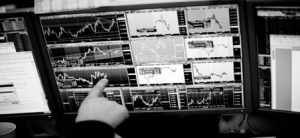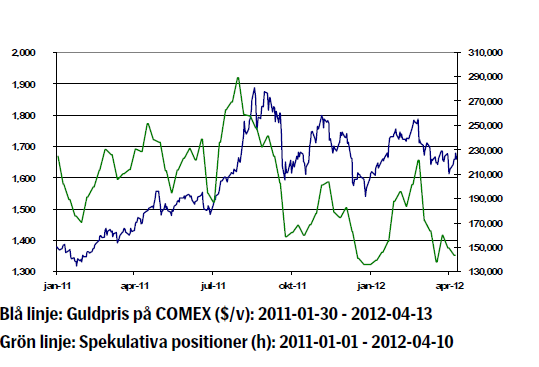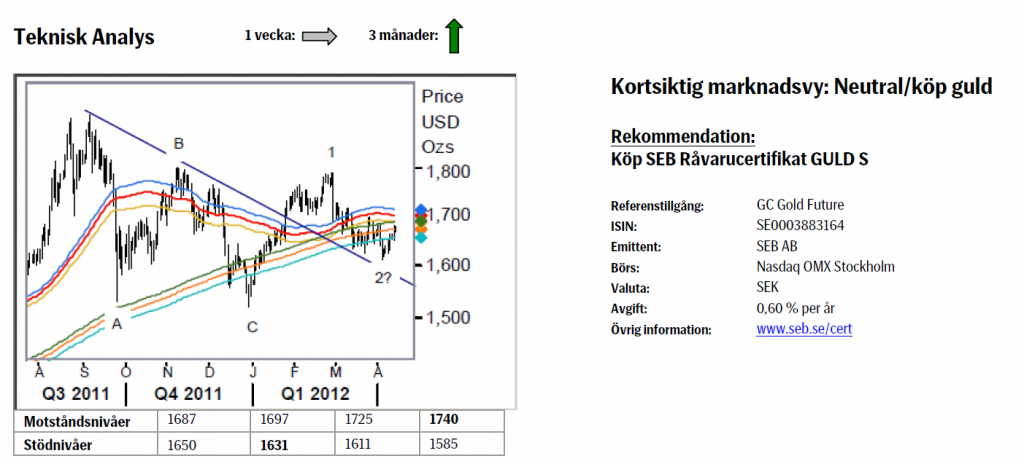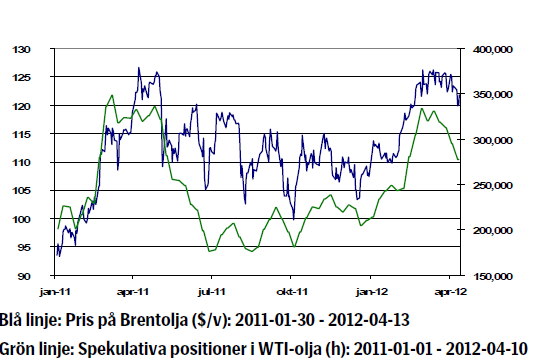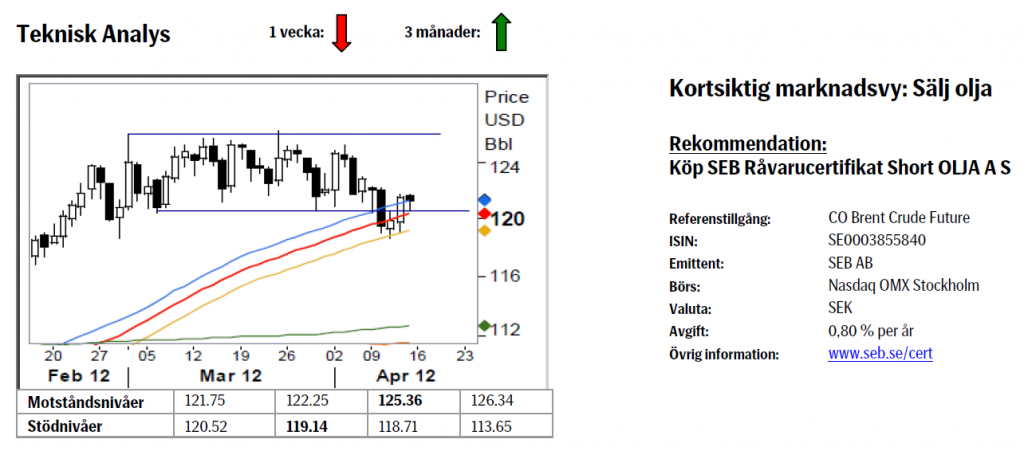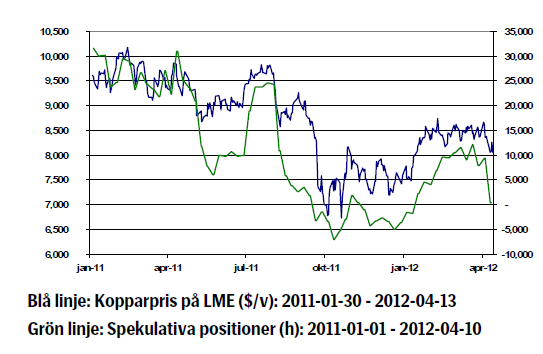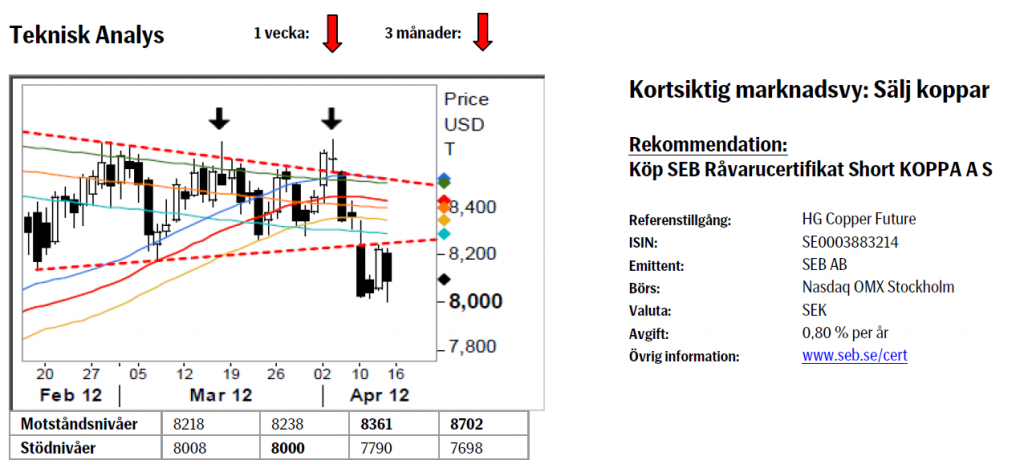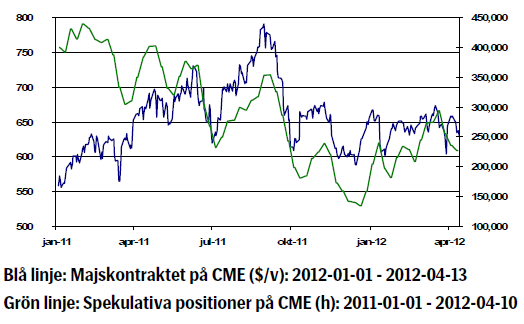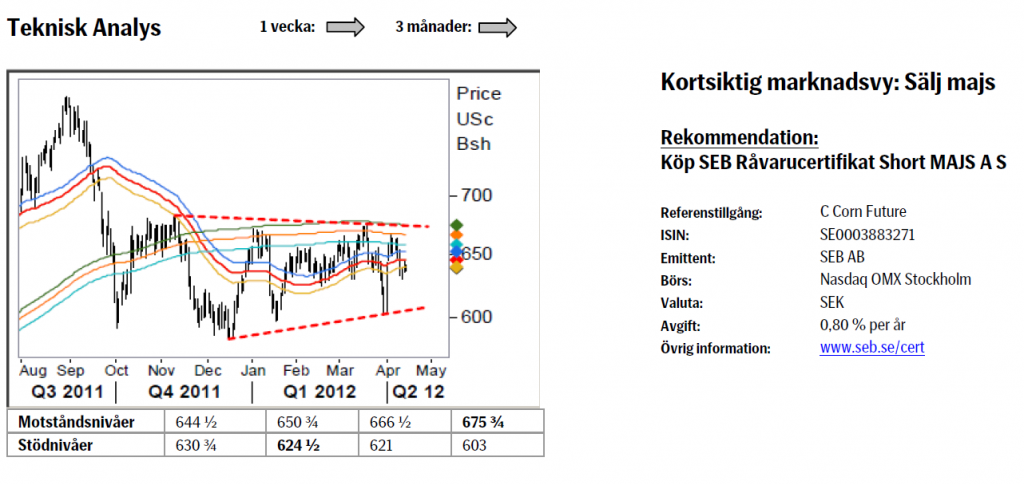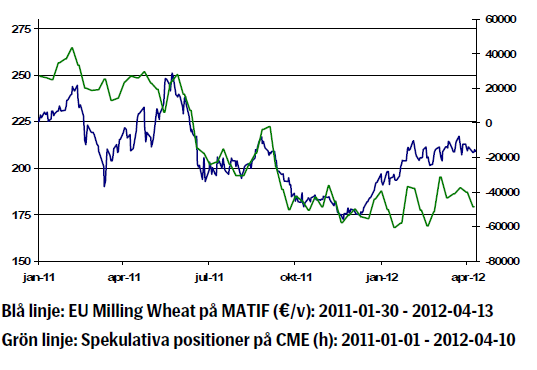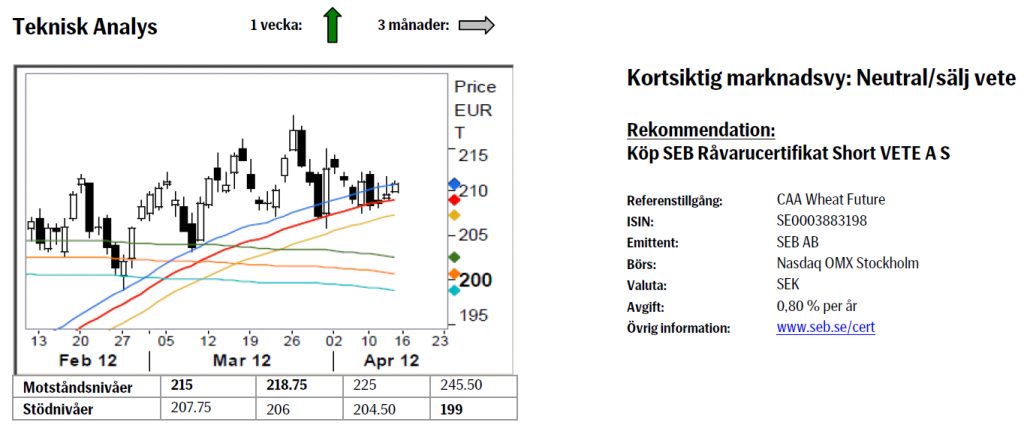Analys
SEB – Råvarukommentarer vecka 16 2012
Sammanfattning: Föregående vecka
- Energi: -1,14 %
UBS Bloomberg CMCI Energy TR Index
- Ädelmetaller: +1,25 %
UBS Bloomberg CMCI Precious Metals TR Index
- Industrimetaller: -2,8 %
UBS Bloomberg CMCI Industrial Metals TR Index
- Jordbruk: -1,85 %
UBS Bloomberg CMCI Agriculture TR Index
Kortsiktig marknadsvy:
- Guld: Neutral/köp
- Olja: Sälj
- Koppar: Sälj
- Majs: Sälj
- Vete: Neutral/sälj
Guld
- Guldpriset föll kraftigt i början av förra veckan men återhämtade sig senare, mycket till följd av en svagare dollar.
- USA presenterade sina senaste jobbsiffror, där nyanmälda arbetssökande var fler än förväntat med en uppjustering till 380 000 mot förväntade 355 000 personer. Detta väcker marknadens förhoppningar om monetära stimulanser. Dollarn sjönk på beskedet då en ökad likviditet ger en svagare valuta. Guldpriset steg som en konsekvens av att ökad likviditet ökar inflationsrisken.
- I Europa stiger oron över Spanien och Italiens stigande räntor. Avkastningen på spanska 10-åriga obligationer steg 18 baspunkter till 6 procent i fredags. ECB antydde att man överväger att köpa stadsobligationer för att motverka vad banken anser vara obefogat höga spanska räntor.
- På grund av en ökad Europeisk oro och en något högre sannolikhet för ytterligare stimulanser i USA förhåller vi oss försiktigt positiva till guldpriset kommande vecka.
- Teknisk Analys: Marknaden har sedan botten (bestående?) den fjärde april stadigt stigit mer eller mindre varje handelsdag och har nu tagit steget upp i den övre delen av 233-dagarsbandet. Uppgången är naturligtvis positiv ur vår synvinkel men tyvärr för liten för att utlösa någon signal. För att detta ska ske krävs som tidigare att vi åtminstone bryter mönstret av fallande toppar dvs. en uppgång över 1697.
Olja
- Priset på Brentolja föll med 0,75 procent under förra veckan. Iran med sitt eventuella kärnvapenprogram fortsätter att oroa omvärlden. International Energy Agency (IEA) förväntar sig att Irans oljeexport kommer att minska med 950 000 fat om dagen när embargot nått sin fulla styrka.
- Saudiarabiens oljeminister uttalade sig förra veckan om utvecklingen hos oljepriset och klargjorde att han inte är nöjd med den höga nivå som nu råder men tror att det kommer bestå under 2012.
- Konflikten mellan norra och det nu självständiga södra Sudan riskerar att eskalera till ett inbördeskrig. 300 000 fat olja per dag från södra Sudan når inte längre världsmarknaden som en konsekvens av denna konflikt.
- Statistiken från Kina la sordin på börsstämningen förra veckan, där kinesisk BNP steg med 8,1 procent på årsbasis under första kvartalet. Det var den lägsta siffran på tre år och nästan en procent lägre än siffran för Q4 2011. Enligt Blombergs prognosenkät hade analytikerna räknat med att BNP skulle öka med 8,4 procent.
- Department of Energy (DOE) rapporterade förra veckan att oljelagret steg 2,8 miljoner fat, mot förväntade 2 miljoner fat. Detta är en säsongsmässig ökning på grund av att raffinaderier gör underhållsarbete.
- Teknisk Analys: Marknaden bröt som förväntat ned ur toppformationen men har hittills fångats upp av köpare i 55dagars bandet. Det är möjligt att vi kommer att få se en hel del stötande o blötande innan nästa rörelse kommer. Men så länge vi inte stiger över 125,36 (bekräftelsepunkt för nya toppar) bör vi i slutändan falla ned igenom 55-dagarsbandet.
Koppar
- Kopparpriset föll totalt 0,13 procent förra veckan, där det största fallet kunde observeras på tisdagen då priset föll fyra procent efter negativa arbetslössiffrorna från USA och en nyväckt oro för den europeiska skuldsituationen. Osäkerheten kring det ekonomiska läget i Kina skapar ytterligare turbulens.
- Världsbanken sänker sin prognos för Kinas BNP-tillväxt i år till 8,2 procent, från tidigare 8,4 procent. Denna prognos kan jämföras med den faktiska siffran för kinesisk BNP-tillväxt under första kvartalet, vilken motsvarade en årlig tillväxt på 8,1 procent. Världsbanken säger vidare att det är möjligt att Kinas ekonomiska tillväxt sjunker till 13-årslägsta i år då en långsam global återhämtning minskar landets export och tillväxten för inhemska investeringar och inhemsk konsumtion minskar.
- Skulle landet sänka både styrränta och bankernas reservkrav i syfte att lätta på krediterna skulle det på sikt påverka kopparpriset positivt, men kortsiktigt ser vi en fortsatt risk på nedsidan.
- Som man kan se i grafen till vänster har spekulanter kraftigt minskat sina positioner i koppar i samband med de senaste veckornas nedgångar.
- Teknisk Analys: Brottet vi varnade för har nu materialiserats och ytterligare nedgångar förväntas inom kort. Innevarande studs/korrektion förväntas vända ned ifrån den brutna trendlinjen och därigenom bekräfta och validera brottet.
Majs
- Med bakgrund av den goda starten på den amerikanska majssådden är trycket på majspriset för närvarande helt klart negativt.
- Onsdagens WASDE-rapport från det amerikanska jordbruksdepartementet (USDA) bjöd inte på några större överraskningar. Att den globala lagernivån skulle justeras ned något jämfört med för en månad sedan indikerades redan vid månadsskiftet mars/april.
- Enligt USDA beror förändringen primärt på en nedjustering av de ingående kinesiska lagren 2012, där foderanvändandet i Kina under slutet av 2011 var högre än vad man tidigare antagit. Kina är en av världens största konsumenter av spannmål, där en väsentlig del av detta går till djurfoder.
- Efter att ha handlats sidledes under veckan föll priset under fredagen, detta på gynnsamma väderförhållanden i de majsproducerande staterna i USA samt oro för den globala tillväxten.
- Fredagens statistik från Kina visade på en långsammare tillväxt än vad marknaden hade förväntat sig. Vidare har den kraftigt ökade upplåningskostnaden för Spanien skapat oro för landets förmåga att på egen hand hantera sina skulder.
- Fundamentalt finns det för närvarande inte mycket som talar för högre priser den kommande veckan. Goda produktionsförutsättningar, oro för minskad efterfrågan från Kina samt en generell riskaversion i marknaden gör att vi bibehåller vi vår säljrekommendation för majs.
- Teknisk Analys: Även framgent gäller att ett brott under 624 ½ eller över 675 ¾ behövs för att utlösa någon form av riktningsinformation (vågmönstret i 60 minutersgrafen håller dock nedsidan för mer trolig). Till dess håller vi fast vid en neutral vy.
Vete
- Förra veckan var rejält slagig för kvarnvetet i Paris. Exempelvis kunde vi under tisdagen se hur handeln startade runt 208 EUR/ton, för att under mitten av dagen ligga på 212,5 och slutligen handlas ner till begynnelsenivån igen . Denna tendens höll i sig hela veckan och den totala nedgången på en procent säger ganska lite om den volatilitet med vilken MATIF-vetet handlades förra veckan.
- Den amerikanska spannmålsproduktionen ser för närvarande mycket ljus ut, där varmt väder i de centrala delarna av landet väntas kunna öka kvaliteten på stora delar av den vintervetesskörd som klarade sig vid köldknäppen under februari och mars.
- Vidare väntas det enligt Bloomberg regn över de vårvetesproducerande staterna den kommande tiden, vilket är gynnsamt för den nyplanterade skörden.
- Nederbörden i Europa under första halvan av april är positiv för den kommande veteskörden och bör kunna trycka priserna nedåt när de förbättrade utsikterna bekräftas från producenthåll.
- Även om de östra delarna av Europa har problem efter den svåra kylan under första kvartalet är detta produktionsbortfall i all väsentlighet inprisat och fundamentalt ser vi en fortsatt nedgång som mest sannolik den kommande veckan. Det som talar mest mot en nedgång är de tekniskt positiva signalerna.
- Teknisk Analys: Även ytterligare besök ned i 55-dagarsbandet har fortsatt rendera köpande. Vi ser fortsatt beteendet som positivt varför vår prognos om högre priser kvarstår.
[box]SEB Veckobrev Veckans råvarukommentar är producerat av SEB Merchant Banking och publiceras i samarbete och med tillstånd på Råvarumarknaden.se[/box]
Disclaimer
The information in this document has been compiled by SEB Merchant Banking, a division within Skandinaviska Enskilda Banken AB (publ) (“SEB”).
Opinions contained in this report represent the bank’s present opinion only and are subject to change without notice. All information contained in this report has been compiled in good faith from sources believed to be reliable. However, no representation or warranty, expressed or implied, is made with respect to the completeness or accuracy of its contents and the information is not to be relied upon as authoritative. Anyone considering taking actions based upon the content of this document is urged to base his or her investment decisions upon such investigations as he or she deems necessary. This document is being provided as information only, and no specific actions are being solicited as a result of it; to the extent permitted by law, no liability whatsoever is accepted for any direct or consequential loss arising from use of this document or its contents.
About SEB
SEB is a public company incorporated in Stockholm, Sweden, with limited liability. It is a participant at major Nordic and other European Regulated Markets and Multilateral Trading Facilities (as well as some non-European equivalent markets) for trading in financial instruments, such as markets operated by NASDAQ OMX, NYSE Euronext, London Stock Exchange, Deutsche Börse, Swiss Exchanges, Turquoise and Chi-X. SEB is authorized and regulated by Finansinspektionen in Sweden; it is authorized and subject to limited regulation by the Financial Services Authority for the conduct of designated investment business in the UK, and is subject to the provisions of relevant regulators in all other jurisdictions where SEB conducts operations. SEB Merchant Banking. All rights reserved.
Analys
Tightening fundamentals – bullish inventories from DOE

The latest weekly report from the US DOE showed a substantial drawdown across key petroleum categories, adding more upside potential to the fundamental picture.

Commercial crude inventories (excl. SPR) fell by 5.8 million barrels, bringing total inventories down to 415.1 million barrels. Now sitting 11% below the five-year seasonal norm and placed in the lowest 2015-2022 range (see picture below).
Product inventories also tightened further last week. Gasoline inventories declined by 2.1 million barrels, with reductions seen in both finished gasoline and blending components. Current gasoline levels are about 3% below the five-year average for this time of year.
Among products, the most notable move came in diesel, where inventories dropped by almost 4.1 million barrels, deepening the deficit to around 20% below seasonal norms – continuing to underscore the persistent supply tightness in diesel markets.
The only area of inventory growth was in propane/propylene, which posted a significant 5.1-million-barrel build and now stands 9% above the five-year average.
Total commercial petroleum inventories (crude plus refined products) declined by 4.2 million barrels on the week, reinforcing the overall tightening of US crude and products.


Analys
Bombs to ”ceasefire” in hours – Brent below $70

A classic case of “buy the rumor, sell the news” played out in oil markets, as Brent crude has dropped sharply – down nearly USD 10 per barrel since yesterday evening – following Iran’s retaliatory strike on a U.S. air base in Qatar. The immediate reaction was: “That was it?” The strike followed a carefully calibrated, non-escalatory playbook, avoiding direct threats to energy infrastructure or disruption of shipping through the Strait of Hormuz – thus calming worst-case fears.

After Monday morning’s sharp spike to USD 81.4 per barrel, triggered by the U.S. bombing of Iranian nuclear facilities, oil prices drifted sideways in anticipation of a potential Iranian response. That response came with advance warning and caused limited physical damage. Early this morning, both the U.S. President and Iranian state media announced a ceasefire, effectively placing a lid on the immediate conflict risk – at least for now.
As a result, Brent crude has now fallen by a total of USD 12 from Monday’s peak, currently trading around USD 69 per barrel.
Looking beyond geopolitics, the market will now shift its focus to the upcoming OPEC+ meeting in early July. Saudi Arabia’s decision to increase output earlier this year – despite falling prices – has drawn renewed attention considering recent developments. Some suggest this was a response to U.S. pressure to offset potential Iranian supply losses.
However, consensus is that the move was driven more by internal OPEC+ dynamics. After years of curbing production to support prices, Riyadh had grown frustrated with quota-busting by several members (notably Kazakhstan). With Saudi Arabia cutting up to 2 million barrels per day – roughly 2% of global supply – returns were diminishing, and the risk of losing market share was rising. The production increase is widely seen as an effort to reassert leadership and restore discipline within the group.
That said, the FT recently stated that, the Saudis remain wary of past missteps. In 2018, Riyadh ramped up output at Trump’s request ahead of Iran sanctions, only to see prices collapse when the U.S. granted broad waivers – triggering oversupply. Officials have reportedly made it clear they don’t intend to repeat that mistake.
The recent visit by President Trump to Saudi Arabia, which included agreements on AI, defense, and nuclear cooperation, suggests a broader strategic alignment. This has fueled speculation about a quiet “pump-for-politics” deal behind recent production moves.
Looking ahead, oil prices have now retraced the entire rally sparked by the June 13 Israel–Iran escalation. This retreat provides more political and policy space for both the U.S. and Saudi Arabia. Specifically, it makes it easier for Riyadh to scale back its three recent production hikes of 411,000 barrels each, potentially returning to more moderate increases of 137,000 barrels for August and September.
In short: with no major loss of Iranian supply to the market, OPEC+ – led by Saudi Arabia – no longer needs to compensate for a disruption that hasn’t materialized, especially not to please the U.S. at the cost of its own market strategy. As the Saudis themselves have signaled, they are unlikely to repeat previous mistakes.
Conclusion: With Brent now in the high USD 60s, buying oil looks fundamentally justified. The geopolitical premium has deflated, but tensions between Israel and Iran remain unresolved – and the risk of missteps and renewed escalation still lingers. In fact, even this morning, reports have emerged of renewed missile fire despite the declared “truce.” The path forward may be calmer – but it is far from stable.
Analys
A muted price reaction. Market looks relaxed, but it is still on edge waiting for what Iran will do

Brent crossed the 80-line this morning but quickly fell back assigning limited probability for Iran choosing to close the Strait of Hormuz. Brent traded in a range of USD 70.56 – 79.04/b last week as the market fluctuated between ”Iran wants a deal” and ”US is about to attack Iran”. At the end of the week though, Donald Trump managed to convince markets (and probably also Iran) that he would make a decision within two weeks. I.e. no imminent attack. Previously when when he has talked about ”making a decision within two weeks” he has often ended up doing nothing in the end. The oil market relaxed as a result and the week ended at USD 77.01/b which is just USD 6/b above the year to date average of USD 71/b.

Brent jumped to USD 81.4/b this morning, the highest since mid-January, but then quickly fell back to a current price of USD 78.2/b which is only up 1.5% versus the close on Friday. As such the market is pricing a fairly low probability that Iran will actually close the Strait of Hormuz. Probably because it will hurt Iranian oil exports as well as the global oil market.
It was however all smoke and mirrors. Deception. The US attacked Iran on Saturday. The attack involved 125 warplanes, submarines and surface warships and 14 bunker buster bombs were dropped on Iranian nuclear sites including Fordow, Natanz and Isfahan. In response the Iranian Parliament voted in support of closing the Strait of Hormuz where some 17 mb of crude and products is transported to the global market every day plus significant volumes of LNG. This is however merely an advise to the Supreme leader Ayatollah Ali Khamenei and the Supreme National Security Council which sits with the final and actual decision.
No supply of oil is lost yet. It is about the risk of Iran closing the Strait of Hormuz or not. So far not a single drop of oil supply has been lost to the global market. The price at the moment is all about the assessed risk of loss of supply. Will Iran choose to choke of the Strait of Hormuz or not? That is the big question. It would be painful for US consumers, for Donald Trump’s voter base, for the global economy but also for Iran and its population which relies on oil exports and income from selling oil out of that Strait as well. As such it is not a no-brainer choice for Iran to close the Strait for oil exports. And looking at the il price this morning it is clear that the oil market doesn’t assign a very high probability of it happening. It is however probably well within the capability of Iran to close the Strait off with rockets, mines, air-drones and possibly sea-drones. Just look at how Ukraine has been able to control and damage the Russian Black Sea fleet.
What to do about the highly enriched uranium which has gone missing? While the US and Israel can celebrate their destruction of Iranian nuclear facilities they are also scratching their heads over what to do with the lost Iranian nuclear material. Iran had 408 kg of highly enriched uranium (IAEA). Almost weapons grade. Enough for some 10 nuclear warheads. It seems to have been transported out of Fordow before the attack this weekend.
The market is still on edge. USD 80-something/b seems sensible while we wait. The oil market reaction to this weekend’s events is very muted so far. The market is still on edge awaiting what Iran will do. Because Iran will do something. But what and when? An oil price of 80-something seems like a sensible level until something do happen.
-

 Nyheter4 veckor sedan
Nyheter4 veckor sedanUppgången i oljepriset planade ut under helgen
-

 Nyheter3 veckor sedan
Nyheter3 veckor sedanMahvie Minerals växlar spår – satsar fullt ut på guld
-

 Nyheter4 veckor sedan
Nyheter4 veckor sedanLåga elpriser i sommar – men mellersta Sverige får en ökning
-

 Nyheter2 veckor sedan
Nyheter2 veckor sedanOljan, guldet och marknadens oroande tystnad
-

 Analys4 veckor sedan
Analys4 veckor sedanVery relaxed at USD 75/b. Risk barometer will likely fluctuate to higher levels with Brent into the 80ies or higher coming 2-3 weeks
-

 Nyheter2 veckor sedan
Nyheter2 veckor sedanJonas Lindvall är tillbaka med ett nytt oljebolag, Perthro, som ska börsnoteras
-

 Analys3 veckor sedan
Analys3 veckor sedanA muted price reaction. Market looks relaxed, but it is still on edge waiting for what Iran will do
-

 Nyheter2 veckor sedan
Nyheter2 veckor sedanDomstolen ger klartecken till Lappland Guldprospektering


